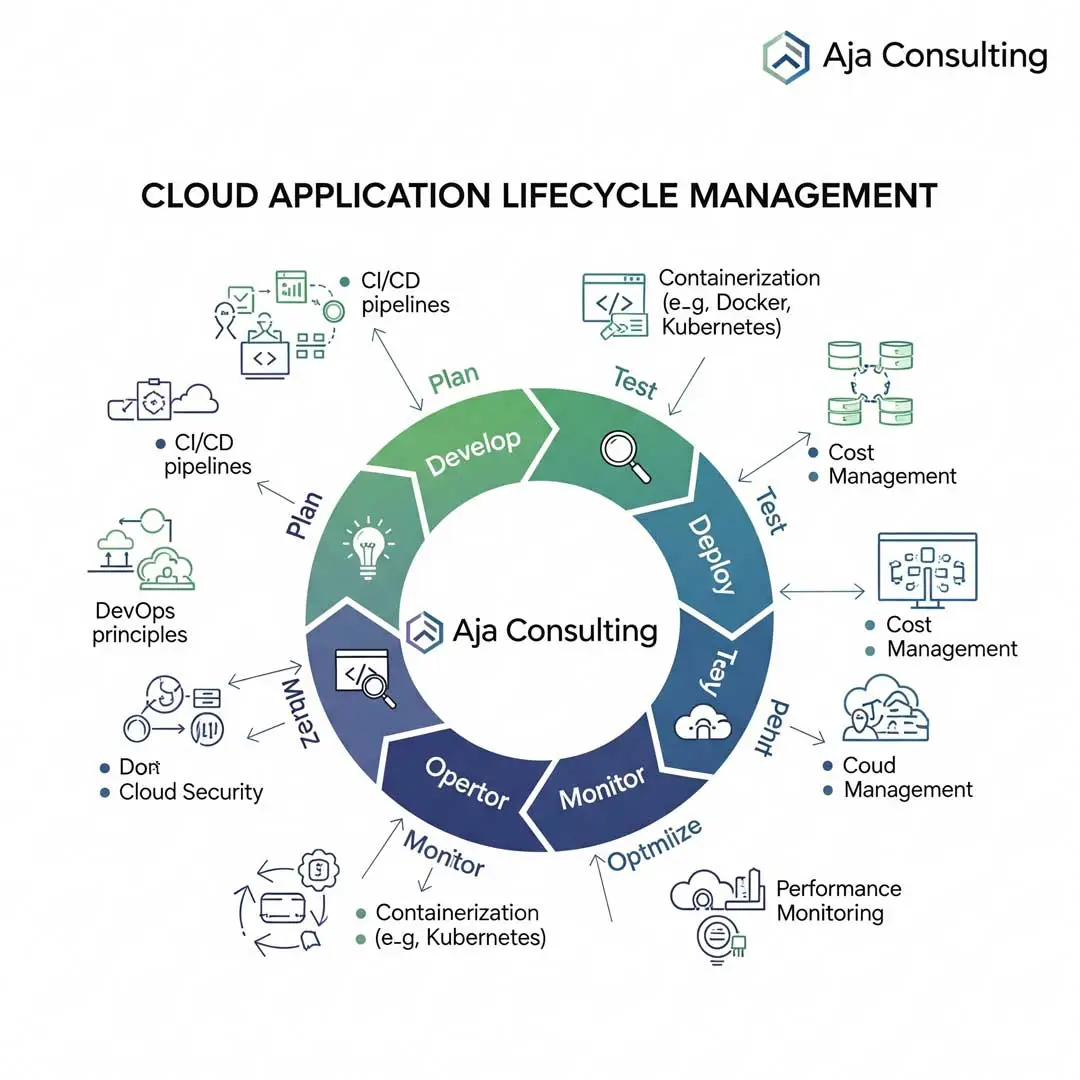More businesses are moving to the cloud. Managing the cloud application lifecycle is key to success. You need a solid plan for developing, deploying, and keeping up with cloud-based applications.
Cloud application lifecycle management helps. It makes processes smoother, improves teamwork, and boosts efficiency.
Cisco Meraki’s cloud management tools are very helpful. They let you watch over, manage, and protect your cloud setup from one place. This makes things easier and lets you solve problems quicker.

Key Takeaways
- Understanding the importance of cloud application lifecycle management in today’s business landscape.
- Learning how to streamline cloud application development and deployment.
- Gaining insights into the role of cloud management tools like Cisco Meraki.
- Discovering best practices for securing and maintaining cloud infrastructure.
- Enhancing collaboration and efficiency through effective cloud application lifecycle management.
What Is Cloud Application Lifecycle Management?
Cloud Application Lifecycle Management (CALM) is about managing cloud apps from start to finish. It’s key for companies using cloud-based supply chains. It makes sure apps are delivered well and work right.
It covers stages like planning, making, testing, deploying, and running apps. Each step is vital to meet quality, security, and performance standards.
| Stage | Description |
|---|---|
| Planning | Defining project scope, goals, and timelines |
| Development | Building cloud-native applications |
| Testing | Ensuring quality and performance |
| Deployment | Streamlining application delivery |
| Operations | Managing and maintaining cloud applications |
By using Cloud Application Lifecycle Management, companies can make their cloud apps better. They work more efficiently and effectively.
The Strategic Business Benefits of Cloud ALM
Cloud ALM helps organizations work better and save money. It gives a single place to manage apps from start to finish. This makes processes smoother and teamwork better.
Cloud ALM makes things more efficient. It automates tasks and gives instant insights. This lets businesses adapt fast to market changes. It also makes it easy to grow apps as needed.
Cloud ALM also cuts costs. It lowers the need for big upfront investments and keeps maintenance costs down. Plus, cloud services charge only for what you use.
Key Benefits of Cloud ALM:
| Benefit | Description |
|---|---|
| Improved Efficiency | Automates routine tasks and provides real-time insights. |
| Cost Reduction | Reduces upfront capital expenditures and minimizes maintenance costs. |
| Enhanced Scalability | Allows easy scaling of applications according to demand. |
Implementing Cloud Application Lifecycle Management in Your Organization
Starting your journey to effective Cloud ALM means understanding how to begin. It’s about taking a strategic approach. This involves many roles and responsibilities.
Roles and Responsibilities
To succeed with Cloud ALM, you need to know who does what. Identify teams and people for each stage, from making to deploying apps. Experts say, “Clear roles and responsibilities are key to avoiding confusion and ensuring a smooth transition to Cloud ALM.”
“Clear roles and responsibilities are key to avoiding confusion and ensuring a smooth transition to Cloud ALM.”
For example, Cisco Meraki Cloud Management can help. It offers a single place to manage network devices and apps.
Required Skill Sets
Having the right skills is also crucial for Cloud ALM success. You need cloud computing, app development, and network management know-how.
- Cloud computing expertise
- Application development skills
- Network management knowledge
By focusing on these skills and using tools like Cisco Meraki Cloud Management, your organization can succeed with Cloud ALM.
Planning Phase: Setting the Foundation for Success
For your cloud application lifecycle management to succeed, planning is key. This phase is about understanding your organization’s needs, setting project goals, and picking the right cloud service model.
IaaS vs PaaS vs SaaS Considerations
Choosing between Infrastructure as a Service (IaaS), Platform as a Service (PaaS), and Software as a Service (SaaS) is a big decision. Each model gives you different levels of control, flexibility, and management.
| Cloud Service Model | Control Level | Flexibility | Management |
|---|---|---|---|
| IaaS | High | High | Self-managed |
| PaaS | Medium | Medium | Partially managed |
| SaaS | Low | Low | Fully managed |
It’s important to know the differences between IaaS, PaaS, and SaaS for good cloud application lifecycle management. Your choice affects how well you can innovate, grow, and manage apps.
Think about your team’s skills, app complexity, and growth needs. By looking at these, you can pick the best option for your business goals.
Development Phase: Building Cloud-Native Applications
Adopting a cloud-native approach in the development phase lets you create apps optimized for the cloud. These apps use cloud computing’s benefits like scalability and flexibility. This makes them perfect for the fast-changing world of cloud-based supply chains.
Cloud-native development focuses on microservices, containerization, and CI/CD pipelines. These methods speed up development, improve app quality, and cut down deployment times. This means you can quickly adapt to new business needs and customer requests.
When making cloud-native apps, security, monitoring, and logging are key. Strong security keeps your apps and data safe. Good monitoring and logging help find problems fast and make apps run better.
Cloud-native development leads to apps that are scalable, flexible, and reliable. This boosts your Cloud ALM strategy’s success. You can then deliver top-notch apps that fulfill your business and customer needs.
Testing Phase: Ensuring Quality and Performance
The testing phase is key in cloud application lifecycle management. It checks if your apps meet quality and performance standards. It also finds and fixes security risks that could harm your apps.
Two main tasks in this phase are vulnerability scanning and penetration testing. These steps make sure your apps are safe and work right.
Vulnerability Scanning
Vulnerability scanning looks for weak spots in your apps and systems. It finds areas that could be used by hackers. This way, you can fix problems before hackers find them.
Penetration Testing
Penetration testing goes further by pretending to be a hacker. It tests how well your apps defend against attacks. This helps you make your security stronger.
| Testing Activity | Purpose | Benefits |
|---|---|---|
| Vulnerability Scanning | Identify potential vulnerabilities | Remediation of vulnerabilities before exploitation |
| Penetration Testing | Simulate real-world attacks | Strengthen security measures through realistic testing |
Adding these tests to your cloud application lifecycle management plan boosts your apps’ security and performance.
Deployment Phase: Streamlining Application Delivery
Efficient deployment is key to unlocking the full potential of your cloud applications. In this phase, you focus on delivering your application to the production environment quickly and reliably.
To achieve this, leveraging a robust cloud management platform like Cisco Meraki cloud management can be highly beneficial. It provides a centralized dashboard for managing your network and applications, ensuring that deployment is not only efficient but also secure.
The benefits of streamlined application delivery include reduced downtime, faster time-to-market, and improved overall application performance. Here is a comparison of traditional deployment methods versus using a cloud management platform:
| Deployment Aspect | Traditional Method | Cisco Meraki Cloud Management |
|---|---|---|
| Deployment Speed | Slow, manual processes | Fast, automated processes |
| Security | Limited security features | Robust security features |
| Management Complexity | High complexity | Simplified management |
By adopting Cisco Meraki cloud management, you can significantly enhance your deployment phase. It makes deployment more efficient and less prone to errors.
Operations Phase: Managing Cloud-Based Supply Chain Applications
Managing cloud-based supply chain apps in the operations phase needs careful planning and action. You must make sure your apps are set up right and keep running well.
Key Challenges: A big challenge is keeping your cloud-based supply chain safe and secure. This means protecting data, controlling who can access it, and using strong security steps.
- Keep an eye on how your apps perform all the time.
- Use strong security steps.
- Follow rules and laws for your data.
To tackle these issues, you can use several good practices. For example, using cloud management tools can help you watch and manage your apps better.
It’s also important to use resources wisely and make sure your system can grow as needed. This way, you can make your cloud-based supply chain apps more efficient and reliable.
Cisco Meraki Cloud Management for Enterprise Applications
More businesses are moving their apps to the cloud. Cisco Meraki Cloud Management offers a strong way to manage these applications. It lets you handle your network and apps from one place, making cloud management simpler.
Key Features of Cisco Meraki Cloud Management:
- Centralized management for networks and applications
- Real-time monitoring and alerts
- Scalability to meet growing business needs
- Enhanced security features
Using Cisco Meraki Cloud Management can make your operations smoother. It helps improve app performance and cuts costs. It’s easy for your IT team to use, thanks to its simple design.
Cisco Meraki Cloud Management is great for big businesses with complex cloud setups. It lets you manage everything from networks to security in one place. This ensures your business runs smoothly.
By choosing Cisco Meraki Cloud Management, you can manage your apps well. This lets you focus on what’s important for your business.
Optimization Phase: Continuous Improvement Strategies
The optimization phase is key in cloud application lifecycle management. It ensures your cloud apps keep getting better.
To do this, you need to focus on continuous improvement. This means finding ways to identify idle resources and implement auto-scaling.
Identifying Idle Resources
Finding idle resources helps cut costs and waste. You should check your resource use often. This way, you can spot unused or underused resources.
Implementing Auto-Scaling
Auto-scaling lets you adapt to changing needs. You set up your cloud to grow or shrink based on demand.
| Strategy | Description | Benefits |
|---|---|---|
| Identifying Idle Resources | Eliminating unused or underutilized resources | Cost savings, reduced waste |
| Implementing Auto-Scaling | Adjusting resources based on demand | Improved responsiveness, scalability |
| Monitoring Performance | Tracking KPIs to identify areas for improvement | Improved performance, reduced errors |
Overcoming Common Challenges in Cloud ALM
When you deal with Cloud Application Lifecycle Management (ALM), you’ll face many challenges. One big one is making sure everything works well with your current setup. This is even harder when you’re working with cloud-based supply chains.
Another problem is not being able to see what’s happening in your cloud-based supply chain clearly. This can cause problems and make things more expensive. To fix this, you need a strong Cloud ALM solution. It should let you watch your apps and services from start to finish.
Keeping your cloud apps safe and following rules is also a big challenge. To solve this, use a Cloud ALM plan that includes top-notch security. This means using things like encryption and access controls, and doing regular checks. This keeps your apps and data safe at all times.
Lastly, handling the complexity of cloud supply chains can be tough. But, you can make it easier by using Cloud ALM tools. These tools help make things run smoother, cut down on mistakes, and make everything more efficient.
By knowing these common problems and using smart strategies, you can beat these challenges. This way, you can really make the most of Cloud ALM.
Preparing for the Future of Cloud Application Management
Cloud computing is always changing, and it’s key to keep up with new trends in Cloud Application Management. Companies need to get ready to use new tech and management ways to stay ahead.
Cisco Meraki cloud management is leading this change. It offers a strong platform for managing cloud apps. With Cisco Meraki, businesses can make their cloud setup better, boost security, and work more efficiently.
To get ready for what’s next, work on a cloud plan that can change with your business needs. This means using cloud-native apps, following continuous integration and delivery, and using tools like Cisco Meraki.
Keep up with the latest in cloud computing to make sure your company stays strong and ready for the future.




